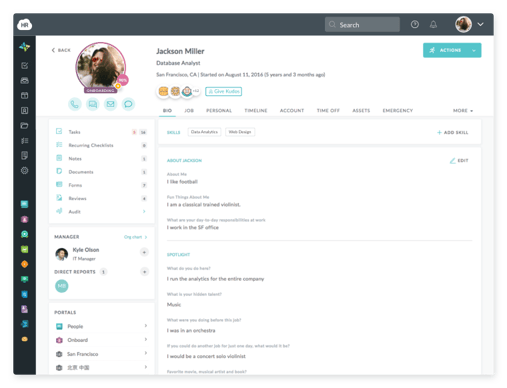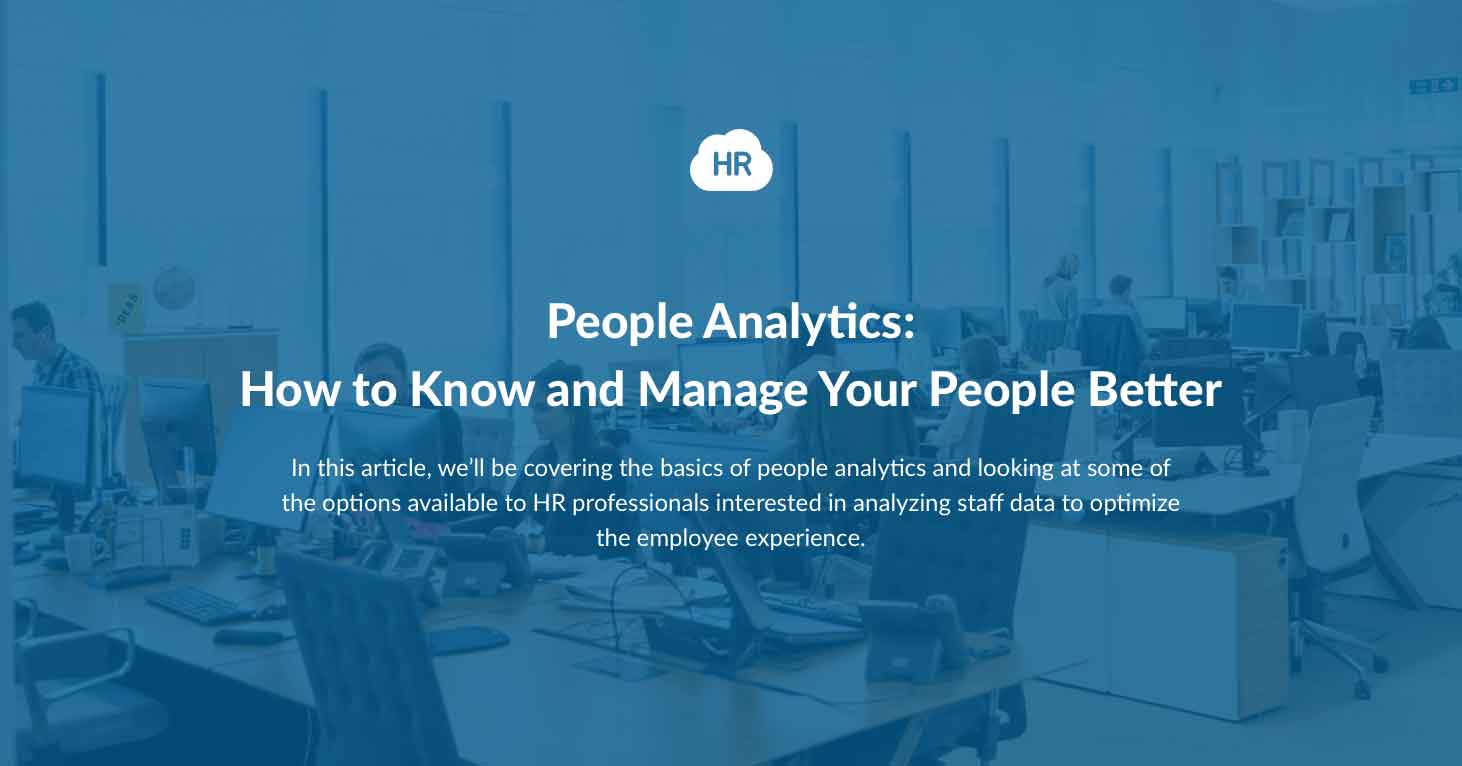The ultimate guide to knowing how your colleagues tick, and more importantly, why. Across multiple fields and industries, we live in an age in which data analytics is helping to streamline business processes and boost efficiency. In the world of HR, a data-driven approach is being used to enhance productivity, decrease staff churn, and create happier, healthier employees. The process of using data analytics in HR is known as people analytics.
In this article, we’ll be covering the basics of people analytics and looking at some of the options available to HR professionals interested in analyzing staff data to optimize the employee experience.
What is People Analytics?
People analytics refers to the technology and process of collecting data on worker activity for the purpose of analysis. Also known as workforce analytics when done in a business context, companies do this in order to improve employee productivity and maintain a happy workforce.
Sources of employee data that can be used for analytics include performance data and staff feedback.
Many HR professionals also integrate their basic performance data, such as sales numbers or customer engagement metrics, with other analytics processes. For example, contact centers use real-time speech analytics that automatically transcribes conversations. This information can then be used for evaluation and training to enhance agents’ performance.
6 Advantages of People Analytics
1. Better Decision Making
While in the past, HR professionals relied on intuition and subjective experience when it came to making decisions. These days analytics software and better employee data are helping to drive more objective, data-based decision-making.
Thanks to people analytics, HR departments are able to generate genuine insights from both performance data and employee feedback in order to make decisions that are statistically more likely to lead to success. HR software can help you answer questions like which worker is best suited to a given task, who would most benefit from professional development courses, and when to redirect resources to best optimize workflows.
2. Improve Staff Retention
One of the most important tasks for HR teams in any business is increasing the rate of staff retention. Ultimately, it’s better to keep staff than to spend lots of time and money recruiting and training new employees.
Thanks to a technique known as predictive modeling, people analytics software is able to flag employees that show signs of having a high level of flight risk. As an HR professional, being able to identify staff members that are at risk of leaving is the first step to being able to proactively encourage them to stay.
3. Increase Transparency
Another central task for HR departments that is improved by people analytics is the process of communicating the hows and whys of business decisions to employees. Embracing people analytics improves transparency because of the simple and intuitive data visualization capabilities of modern analytics software.
Clear and effective communication is important because if people can see and interpret data for themselves they’re able to better understand what is required of them in the context of strategic business objectives. This leads to increased accountability and better relationships with managers and administrators
Transparency is especially key to successful remote workforce management, where different means and levels of communication can sometimes lead to misunderstandings.
4. More Satisfied Employees
Workforce engagement is essential for running a successful business. Happier employees are more productive, more efficient, and more loyal. At the end of the day, employee satisfaction is what HR is all about.
Using people analytics can help you to identify the effect of certain policies and decisions on employee satisfaction. It can help you to gauge the effect of executive decisions and to spot areas where staff are becoming disengaged or demoralized. With this knowledge, you can make the necessary changes to remedy the situation.
5. Hire the Best People
As well as helping you to retain the best workers, people analytics can be used to help ensure you hire the best people in the first place.
With the right analytics program, it’s possible to create a predictive model from the data generated by your best employees. Applying this model during the assessment of potential hires then allows you to leverage the data from your top performers in order to predict who’s statistically most likely to achieve similar results.
6. Save time
As anyone who works in HR or recruitment knows, finding, hiring, and training the best talent can take a lot of time.
People analytics can save you a significant amount of time by showing you better ways of prioritizing your tasks and ensuring that you’re spending time on the things that actually make a difference.
How to Get Started
Getting an effective people analytics program going needn’t be complicated. There are plenty of tools out there that put powerful analytics capacity at your fingertips. But before we get on to the software options available, we first need to understand the stages involved.
1. Gather Data
The first stage in any people analytics venture will always be to gather the necessary data. If you don’t have an effective data pipeline you will have nothing to run through whichever software you wish to use to gain insights.
If it’s performance data you’re after it’s likely that whichever digital tools your workers use already gather this data, or can be programmed to do so. Check what format your data needs to be in before you input it into any software and make sure all your data capture processes are compliant with the relevant privacy laws and your employees’ contracts.
Another valuable source of data in the field of HR is employee surveys. Some analytics platforms have this function built-in but it’s also possible to set up your own surveys.
There are plenty of processes that you likely already implement that generate useful data too. For example, with people analytics, accident and injury reports can be leveraged to help create a more safe workplace.
2. Build and Apply Models
Once you have amassed the required data it’s just a matter of using the right software to generate insights by building both predictive and prescriptive models.
Modern analytics techniques mobilize machine learning, artificial intelligence, and various other data science methodologies to create models.
A predictive model is one that uses your data to talk you the most statistically likely result given certain known variables. A prescriptive model is one that helps with decision-making. It tells you which course of action out of multiple options is probabilistically the most advantageous according to the desired outcomes.
3. Visualize and Interpret Results
One of the biggest advantages of today’s analytics tools is their ability to create meaningful visualizations out of otherwise dense and indecipherable datasets. A good visualization is key to interpreting the results of your analytics in a way that optimizes the labor of your workforce.
Getting creative with your data visualization can lead to unexpected insights that the data alone would never reveal if it was left in purely numerical form.
4. Implement Changes
Alongside customer experience analytics, people analytics can be one of the biggest ways that Big Data can help to improve your business’s performance. But only if you act upon the insights gained.
While prescriptive models will give you tell you directly what the optimal approach to a given challenge is, acting upon the results of predictive models will require you to make further calculations based upon the predictions. Combining predictive and prescriptive analytics is the most advanced way to create insight from your data and then act upon it.
What Is an HR dashboard?
An HR dashboard is one of the most important tools for organizations looking to leverage the power of people analytics. An HR analytics platform compiles all the known information about your workers in a single place and allows you to run sophisticated data processes from an intuitive dashboard.\

There are many HR dashboards on the market. Some of the most popular include:
- HR Cloud
- Workday
- Anaplan
- Bamboo HR
- OfficeVibe
- Orgvue
- Visier People
- HiBob
When deciding which platform is most suitable for your business needs, you should consider which key performance indicators (KPIs) you’ll be monitoring, what kind of data you have available, and what data analysis features you require.
People Analytics and Remote Work
Whether you work in a hundred-year-old business with thousands of employees or for a start-up with a small intimate team of staff, remote working is a reality for many businesses. It’s also an employment model that is only likely to grow, with many generation Z employees saying that they prefer remote or hybrid working over rigidly location-based office jobs.
While there are plenty of businesses such as virtual law firms that now operate entirely without an in-location workforce, the hybrid approach has also proven popular but it comes with its own dilemmas. Businesses that offer a combination of in-office and home working are asking what the correct balance is? When to ask employees to come into a physical location? And whether home working requires or benefits from more flexible work hours?
Conclusion
Now you know what people analytics is, and how it could help your organization, all that’s left to do is take the leap.
Many of the tools and platforms discussed in this blog offer free trials so that you can try out a product or service before you commit to any purchase or subscription. With that in mind, what’s stopping you?
Author Bio:
Grace Lau - Director of Growth Content, Dialpad
Grace Lau is the Director of Growth Content at Dialpad, an AI-powered cloud communication platform enhancing the digital employee experience for better and easier team collaboration. She has over 10 years of experience in content writing and strategy. Currently, she is responsible for leading branded and editorial content strategies, partnering with SEO and Ops teams to build and nurture content. Here is her LinkedIn.
Keep Reading
Remote Onboarding Done Right: A Step-by-Step Guide for HR Teams
When a new hire walks into your office, you smile, shake hands, and show them around. But
Importance of Onboarding: Purpose, Benefits, and What It Means for Your Workplace
Think about the last time you joined a new team. You had questions, maybe even doubts.

